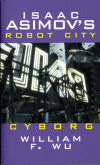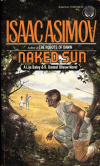My favorite science fiction writer by far is Isaac Asimov (1920-1992). One of the main reasons I started this website was to document my re-reading of his Robot and Foundation books. I recount my introduction to his writing in my post celebrating his 90th birthday. There I mention starting to read his autobiography. That actually was the first volume, In Memory Yet Green (1970) covering his life from 1920-1954. It was an out of print low quality hard back copy. I still have that volume, but for some reason I never got around to finishing it. My last bookmarked page was 167 of 708. His next volume was In Joy Still Felt (1980) covering his life from 1954-1978. I fully intended on reading both of those, then finally his third volume (for this review) I, Asimov: A Memoir (1992).
Since my post in 2010, I’ve shifted almost all of my reading to ebook formats. Unfortunately I could not find any of the old volumes on ebook. My physical copy of In Memory Yet Green sat on the shelf collecting dust, literally! Sometime last year there was a sale on this book on the Google Play Store for just a buck or two. I snatched it up immediately and put it on my short list to read after finishing John Scalzi’s Old Man’s War series which I was in the middle of at the time.
For a while I was frozen with indecision. Should I dig harder and try to find the first two volumes in ebook format? Drudge through the physical copy I had and then find the out of print second volume? Luckily I checked out some of the reviews. This third volume isn’t just 1978-(present at time of publish), but covers his entire life. The format is also not strictly chronological, but jumps from subject to subject. I was hesitant at first, partially from having a tendency to want to read things chronologically, even if they are published out of order (see my reading project). The more I thought about it, the closer I came to realizing it didn’t matter! I could read the third volume, then go back and read the first two, and maybe the third again! There is actually a 4th autobiography, It’s Been a Good Life (2002) that was edited after his death by his second wife Janet Jeppson Asimov. I plan on reading as well, possibly before the first two volumes.
If you are at all interested in Isaac Asimov, or science fiction in general, you must read this book. Having already had a false start on In Memory Yet Green, I can say I enjoyed this format better. Most “chapters,” which I will call topics, are at most five to ten pages in length. This makes for easy stopping points. I found myself reading many topics throughout the day, with several back to back during my lunches, where I normally spend most of my time reading. (more…)


I enjoyed the first two books in the series. The problem with this book was the constant repetition of the laws of robotics. I also was annoyed at the humans’ constant manipulation of the laws to get the robots to do what they wanted them to do. Robots never need to be reminded of the laws, they are programmed to follow them. Robots must do what they are told unless it interferes with the first law, so why the manipulation? I think the author needed to state the laws maybe one time and then the humans could have created the situations where the robots would have to follow the laws without the constant reminding.
I did enjoy the plot line about the cyborg and the mental effects of becoming a combination of man and robot. I am hoping that the writing in the rest of the series goes back to the quality of the first two books.
From what I remember, some of the books in this series are better than others. Since they are all done by different authors, the next one might be better. I think that Prodigy was one of my favorites of the six. Unfortunately, this same author (of Cyborg) is the author of the last book as well.